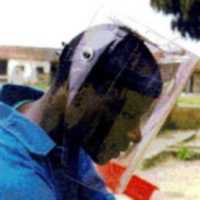Humanitarian landmine clearance
Sustainability and Demining - Oil and Water?
Mines are weapons of war, and sustainability is simply not an issue during wars, achieving short and long term military objectives and staying alive override less immediately urgent concerns. Mine clearance also has so many important safety and procedural issues that sustainability has had no place historically in planning and designing equipment. Sustainability is not, however, an ingredient that can be added on to a final prototype before production starts, if it is not part of the design itself, of the methodology behind the design and of the manufacturing, then the tools and equipment for demining will not be sustainable.
This is not a situation unique to the world of demining. Throughout disaster relief and emergency response work there is the same dilemma of the need to save lives by responding immediately, in competition with the need for sustainability both to avoid long-term problems, and also to make what is being done widely repeatable in other places facing the same emergency. There has been a wide-ranging debate of this by development workers for over ten years; no one claims to have the answer but consensus has emerged on some of the underlying ideas.
Some of the distinguishing characteristics of sustainable technologies are considered to be:
- low cost and easy duplication so that large tasks are broken down into small tasks that large numbers of people with relatively low levels of formal education can attempt at the same time
- the use of simple equipment and, if necessary, the employment of more local people to avoid capital intensive methods
- many of the equipment resources are either locally available or at least locally repairable
- appropriate levels of technology are used that are highly adaptable to different situations
Sustainablility is not such an important issue when clearing a few high-priority mined areas like essential roads and important buildings, but the vast bulk of mine contaminated land is low-value farmland with very few mines per hectare. The high cost methods applied to highest priority demining are simply not viable either economically or in terms of the time taken. If we are to take seriously the idea of clearing almost all mines within 20 years we need much cheaper technology that is more appropriate to the local conditions and specifically designed for sustainability.
The end user is an important person in the design process of any equipment. Without adequate consultation of their needs and methods ,and their way of working and of analysing, there is little hope of designing tools that are really going to be sustainable. Unless a repair engineer or technician thoroughly understands the function of the equipment and has some insight into how it is manufactured and assembled we cannot hope to achieve sustainability in the maintenance and repair of the equipment, let alone the chance to incorporate new ideas and methods that come from the bright ideas and unique insights of those who live and work with mines in their own countries and cultures.
Sustainability demands that we address the current near-total reliance on importing both equipment and "know-how" from a very few of the richest countries of the planet. Almost all demining tools and equipment are currently imported to the poor countries from the rich countries; visors, metal detectors, hand-held radar, specialist protective equipment, mechanised vegetation clearance, and high cost advanced detection systems. Not only does this make them very expensive but it also makes them essentially unrepairable where they are used and less comprehensible to the end user. There is nothing intrinsic about this, the majority of electronics assembly world-wide is done in 'Free Trade Zones' in poor countries, and most electronic components are manufactured in countries of the Third World, including mine polluted countries like El Salvador. There is however a concentration of not just economic interest but technical information in the richest countries that creates a gulf; without access to this information sustainable design is nearly impossible. There is little hope of eliminating mines within a generation unless we start to bridge the information gap now in order to start producing sustainable demining equipment. The way has already been pioneered in other areas of sustainable development and involves a partnership between those who work in the heavily mine contaminated poor countries and those who have the information, technical and "know-how" resources in the rich countries. Sustainability will not arrive by accident but by deliberate and well-planned procedures focussed on the problem in hand.


